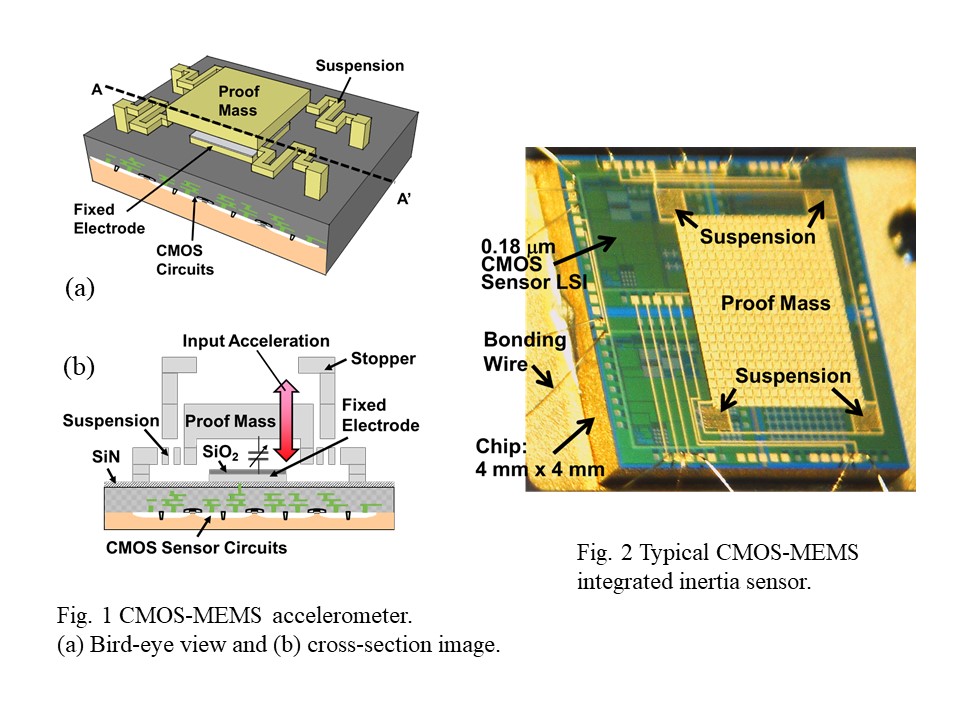Abstract
Microelectromechanical systems (MEMS) inertia sensors, such as MEMS accelerometers, are now widely used for a variety of applications in automotive, industrial, healthcare, entertainment, consumer handheld electronics, etc. In this paper, we present our recent progress of a highly sensitive CMOS-MEMS inertia sensor and its application to early-stage diagnosis of Parkinson's disease.
(1) Highly sensitive CMOS-MEMS inertia sensor using Au as proof mass
Figure 1 shows the conceptual image of the CMOS-MEMS inertia sensor. The MEMS structure is fabricated onto standard CMOS wafer using so-called post-CMOS process. Electroplating Au is used. The feature MEMS device is the use of Au proof mass, which contributes to reduce the BN in the inertia sensor. The BN of moving structures determines the sensitivity of MEMS accelerometer. BN is expressed as BN=(4kB T b)1/2/m, where kB, T, b and m are the Boltzmann constant, the absolute temperature, the viscous damping coefficient and the mass of the movable structures of an inertial sensor, respectively. Large the density of the proof mass results in suppressing BN without sacrificing the device footprint.
The reason why we use Au as proof masu is that the density of Au is almost an order of magnitude higher than the density of Si that is used as the standard material for proof masses.
Today, commercial MEMS inertia sensors accommodate typically more than 1G (1G = 9.8 m/s2: gravitational acceleration). On the other hand, accurate sub-1G to micro-G sensing by using MEMS inertial sensors has potential to realize various unexplored applications, such as precise monitoring of human and non-human objects for healthcare and medical purposes or integrated inertial measurement unit for advanced navigation systems. At present time, 0.1micro-G/Hz^(1/2) Brownian Noise MEMS inertia sensor is available in our research group. Our MEMS sensor has enough performance for detecting microgravity.
Figure 2 shows a photo of typical CMOS-MEMS inertia sensor. Control of crystal structure of Au is essential when Au is used as proof mass. Analysis of Au crystal structure and novel Au electroplating technology will be presented at the conference. Also, detail process flow of CMOS-MEMS inertia sensor is presented.
(2) Early-stage diagnosis of Parkinson's disease
Parkinson's disease is originated from lack of dopamine secretion. Early-stage diagnosis enables the delay of symptom progress and/or the interval extension of Levodopa dosing, resulting in quality-of-life (QoL) improvement of Patient. Parkinson's disease (PD) is categorized by Hoehn-Yahr (HY) scale from 1(light) to 5 (heavy).
We have developed diagnosis of Parkinson's disease using CMOS-MEMS inertia sensor. So far, walking trajectory and postural abnormality of PD patients and healthy person are analyzed based on machine learning technique. PD patients and healthy individuals can be classified with an accuracy of over 90%.
Recently, we have succeeded in detecting the micro musclar sound of the index finger for the first time using a high-sensitivity inertia sensor whose noise level is 10 dB lower than commercially available sensors. These techniques will open a new door of Early-stage diagnosis of Parkinson's disease. Details of diagnosis of Parkinson's disease using CMOS-MEMS inertia sensor will be discussed in the presentation.
Acknowledgement: This work was financially supported by JST CREST Grant Number JPMJCR1433, Japan, and JSPS KAKENHI Grant Number 19K05232.

Figure 1
